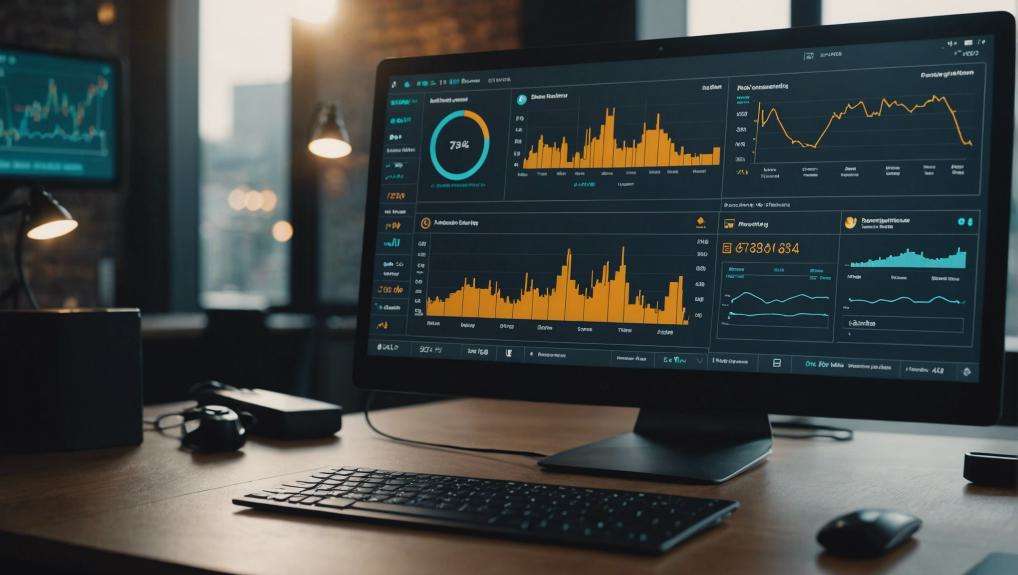Table of Contents
Conversational Analytics Software transforms how I analyze customer interactions, offering real-time insights. It helps me tailor products and services swiftly, essential in today's data-driven market.
Main Talking Points
- Utilizes Natural Language Processing (NLP) for data analysis.
- Provides real-time insights into customer interactions.
- Integrates data from multiple communication channels.
- Offers customizable dashboards for interactive data visualization.
- Enhances decision-making with AI-driven predictive analytics.
Importance of Conversational Analytics

Understanding the significance of conversational analytics is essential for optimizing business strategies and enhancing customer experiences. As a business owner, I've realized the immense value that conversational analytics bring to the table. By analyzing customer interactions in real-time, I can gain valuable insights into their preferences, pain points, and overall satisfaction levels. This data allows me to tailor my products and services to better meet customer needs, ultimately leading to increased satisfaction and loyalty.
Moreover, conversational analytics provide me with the opportunity to identify trends and patterns that may not be apparent through traditional data analysis methods. By understanding these trends, I can make more informed decisions regarding marketing campaigns, product development, and customer service strategies. This proactive approach enables me to stay ahead of the competition and adapt quickly to changing market dynamics.
Key Features and Functionality
Exploring the key features and functionality of conversational analytics software has been integral to optimizing my business strategies and enhancing customer experiences. The capabilities of this software have truly revolutionized the way I interact with data and derive insights. Here are some key features that make conversational analytics software a powerful tool for businesses:
- Natural Language Processing (NLP): By leveraging NLP, the software can understand and interpret human language, enabling users to ask questions in a conversational manner.
- Real-time Insights: The ability to provide real-time data analysis allows for quick decision-making and the identification of trends as they happen.
- Multi-Channel Integration: This feature enables the software to gather data from various communication channels such as chat, email, and social media, providing a holistic view of customer interactions.
- Customizable Dashboards: The software offers customizable dashboards that can be tailored to specific business needs, allowing for a personalized analytics experience.
Benefits for Customer Experience

Having harnessed the key features and functionality of conversational analytics software, the benefits it brings for customer experience are significant and transformative. This software allows businesses to gain deep insights into customer interactions, preferences, and sentiments. By analyzing these conversations, companies can identify patterns, trends, and areas for improvement, leading to more personalized and efficient customer service.
Moreover, conversational analytics software enables real-time monitoring of customer interactions across various channels, such as chatbots, social media, and emails. This capability allows businesses to promptly address customer queries, resolve issues faster, and provide instant support, ultimately enhancing the overall customer experience. Additionally, by understanding customer feedback and behavior through this software, organizations can tailor their products and services to better meet customer needs and expectations.
In essence, the utilization of conversational analytics software not only streamlines customer interactions but also fosters stronger relationships with customers by delivering more personalized and satisfactory experiences.
Enhancing Marketing Strategies
To elevate marketing strategies effectively, incorporating conversational analytics software provides invaluable insights and data-driven solutions. This technology enables businesses to understand customer behavior, preferences, and sentiments more deeply, leading to targeted and personalized marketing campaigns.
Here are four key ways conversational analytics software enhances marketing strategies:
- Real-time Customer Feedback: By analyzing conversations in real-time, I can quickly identify emerging trends, customer pain points, and areas for improvement, allowing for immediate adjustments to marketing strategies.
- Optimized Content Creation: Utilizing conversational analytics helps me understand which types of content resonate most with customers, enabling me to tailor marketing materials for maximum engagement and impact.
- Personalized Campaigns: With detailed insights into individual customer interactions, I can create highly personalized marketing campaigns that are more likely to convert leads into sales.
- Competitor Analysis: By analyzing conversations not only from my own customers but also from competitors, I gain a competitive edge by understanding market gaps and customer perceptions, informing my marketing strategies to stand out in the industry.
Leveraging Data for Business Insights

Utilizing data analytics software reveals valuable business insights that drive informed decision-making and strategic planning. By analyzing data trends, patterns, and customer behaviors, businesses can gain a deeper understanding of their operations and market dynamics. This information empowers me to identify opportunities for growth, optimize processes, and enhance customer experiences.
One significant advantage of leveraging data for business insights is the ability to track key performance indicators (KPIs) in real-time. I can monitor metrics such as sales figures, customer satisfaction levels, and marketing campaign effectiveness, allowing me to make timely adjustments to improve overall performance. Additionally, data analytics software enables me to forecast future trends and anticipate market changes, giving me a competitive edge in a rapidly evolving business landscape.
Industry Applications and Case Studies
In the domain of conversational analytics software, industry applications and case studies provide tangible examples of how businesses have successfully integrated this technology into their operations. One such case study is how Company X utilized conversational analytics software to enhance customer service by analyzing customer interactions in real-time.
Here are some key industry applications and case studies that showcase the effectiveness of conversational analytics software:
- Retail Enhancement: Company Y implemented conversational analytics to understand customer preferences and tailor their offerings, resulting in a significant increase in sales.
- Healthcare Optimization: Hospital Z utilized conversational analytics to streamline patient interactions, leading to improved appointment scheduling and patient satisfaction rates.
- Financial Services: Bank A integrated conversational analytics to analyze customer inquiries, enabling them to provide personalized financial advice and improve customer retention.
- Hospitality Sector: Hotel B leveraged conversational analytics to automate reservation processes and enhance guest experiences, resulting in higher ratings and positive reviews.
Integration With CRM Systems

Conversational analytics software seamlessly integrates with CRM systems to enhance customer relationship management efficiency. By connecting these two powerful tools, businesses can gain valuable insights from customer interactions, improving communication and personalization. The integration allows for a holistic view of customer data, including conversations, preferences, and feedback, all in one centralized location. This unified approach enables companies to track customer journeys more effectively, identify trends, and tailor their strategies to meet individual needs.
Moreover, the integration with CRM systems streamlines processes by automatically updating customer profiles with real-time conversational data. This automation reduces manual data entry errors and guarantees that the information is always up to date. As a result, customer service teams can deliver more personalized support, addressing issues promptly and proactively. Additionally, by analyzing conversational data within the CRM system, businesses can identify opportunities for upselling, cross-selling, and customer retention strategies, ultimately driving revenue growth and customer satisfaction.
Future Trends and Innovations
I foresee a shift towards AI-driven data insights in conversational analytics software, revolutionizing how businesses interpret and utilize customer interactions.
Predictive analytics applications are poised to become a key component, enabling organizations to anticipate customer needs and behaviors with greater accuracy.
These advancements will unquestionably reshape the landscape of customer engagement and drive more personalized interactions.
Ai-Driven Data Insights
Exciting advancements in artificial intelligence are revolutionizing the way businesses harness data insights for improved decision-making and strategic planning. This cutting-edge technology is shaping the future of data analytics by providing deeper and more valuable insights than ever before.
Here are four key ways Ai-driven data insights are transforming the business landscape:
- Enhanced Predictive Capabilities: Ai algorithms can analyze vast amounts of data to predict future trends and outcomes accurately.
- Real-time Analysis: Ai enables businesses to access real-time data insights, allowing for quicker decision-making and response to market changes.
- Personalized Recommendations: Ai-driven insights can provide personalized recommendations to customers based on their behaviors and preferences.
- Optimized Operations: Businesses can optimize their operations by leveraging Ai insights to streamline processes and improve efficiency.
Predictive Analytics Applications
As predictive analytics continues to evolve, businesses are increasingly embracing innovative applications to anticipate future trends and drive strategic decision-making. One key trend is the integration of predictive analytics with conversational analytics software, enabling companies to gain deeper insights from customer interactions. By analyzing conversational data in real-time, organizations can predict customer behavior, preferences, and needs more accurately.
Another emerging application is the use of predictive analytics in supply chain management to forecast demand, optimize inventory levels, and enhance overall operational efficiency. Additionally, predictive analytics is being leveraged in healthcare to predict patient outcomes, personalize treatment plans, and improve healthcare delivery. These advancements signify a shift towards more proactive decision-making based on predictive insights.
Choosing the Right Software Provider

Selecting the appropriate conversational analytics software provider can have a significant impact on the success of your business operations. When choosing a software provider, there are several key factors to evaluate to make the right decision:
- Technology Compatibility: Assess if the software integrates seamlessly with your existing systems to avoid complications during implementation.
- Scalability: Make sure that the software can grow with your business to accommodate increasing data volumes and evolving analytical needs.
- Customization Options: Look for providers that offer customizable solutions tailored to your specific business requirements for best performance.
- Support and Training: Evaluate the level of support and training provided by the software provider to assist your team in effectively utilizing the software.
Implementation Best Practices
When implementing conversational analytics software, it's important to establish clear objectives and timelines for a successful deployment. Setting specific goals helps focus the implementation process and ensures that the software aligns with the organization's needs. It's essential to involve key stakeholders from different departments to gather diverse perspectives and requirements, enabling a more thorough implementation plan.
Another best practice is to conduct thorough training sessions for users to familiarize them with the software's functionalities. This step promotes user adoption and maximizes the software's potential benefits. Regular communication with the software provider is also crucial during the implementation phase to address any issues promptly and ensure a smooth deployment process.
Moreover, conducting pilot tests with a small group of users can help identify any potential challenges or areas for improvement before rolling out the software company-wide. This iterative approach allows for adjustments to be made early on, reducing disruptions once the software is fully implemented. By following these best practices, organizations can increase the chances of a successful conversational analytics software implementation.
Frequently Asked Questions
How Does Conversational Analytics Software Ensure Data Privacy and Security?
To guarantee data privacy and security, I implement encryption, access controls, and regular security audits. By following best practices and staying informed on emerging threats, I aim to protect sensitive information from unauthorized access.
Can Conversational Analytics Software Analyze Sentiment and Emotions Accurately?
Yes, sentiment and emotions can be accurately analyzed. By utilizing advanced algorithms and natural language processing techniques, it's possible to gain valuable insights from text data, providing a deeper understanding of people's feelings and attitudes.
What Are the Typical Challenges Faced During the Software Implementation Process?
During software implementation, challenges like integration issues, user resistance, and training gaps may arise. It requires effective communication, teamwork, and adaptability to overcome these obstacles successfully and guarantee a smooth shift for all stakeholders involved.
Does the Software Support Multiple Languages for Global Customer Interactions?
Yes, our software supports multiple languages for global customer interactions. It enhances user experience by enabling communication in various languages. This feature fosters engagement and guarantees effective communication, catering to diverse linguistic preferences and needs.
How Customizable Is the Reporting Dashboard in Conversational Analytics Software?
Reporting dashboard customization varies, offering options like data visualization, widget configuration, and personalized layouts. I can tailor the dashboard to display key metrics, trends, and insights that align with specific reporting needs and preferences.
Conclusion
Overall, conversational analytics software is a game-changer for businesses looking to improve customer experience, enhance marketing strategies, and gain valuable business insights. By leveraging data from customer interactions, companies can make informed decisions and drive growth.
Choosing the right software provider and implementing best practices are key to maximizing the benefits of this technology. As the industry continues to evolve, staying ahead of future trends and innovations will be essential for success.
